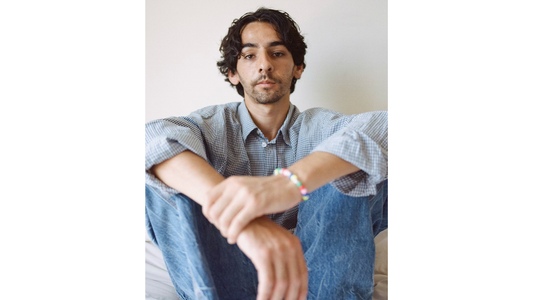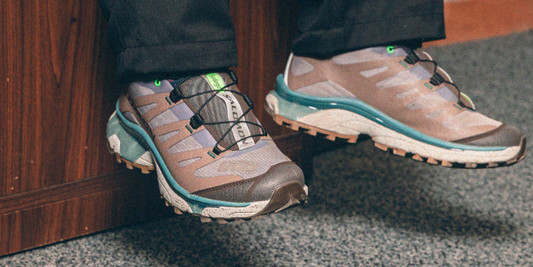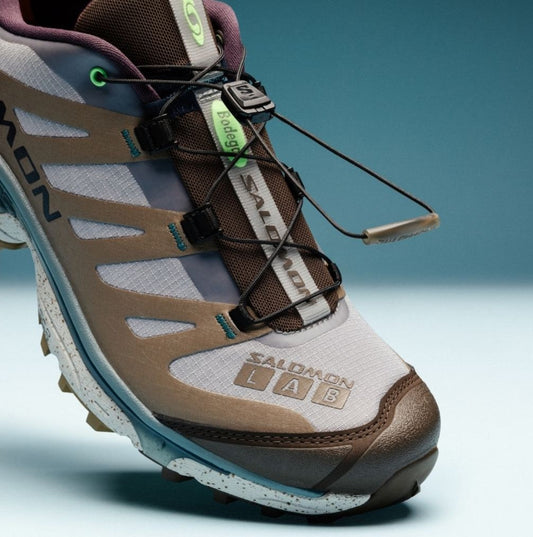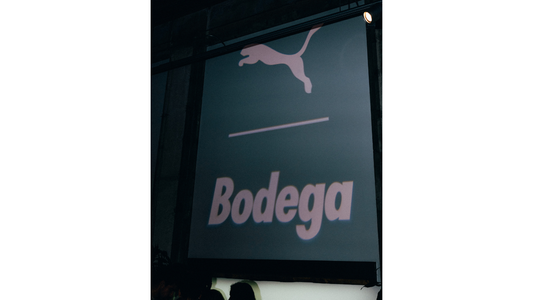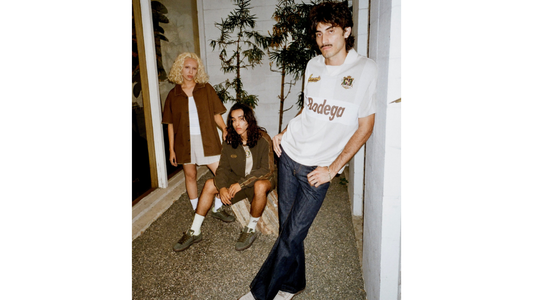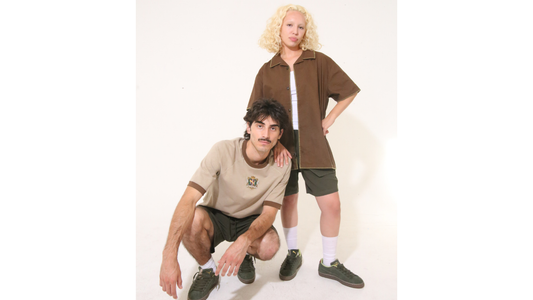Dr. Martens’ Creative Director Damien Wilson talks about the brand’s legacy, future and the signature design elements that continue to make Dr. Martens shoes unique.
This year marks the 60th anniversary of the Dr. Martens 1461. Released exactly one year after the 1460 boot, and named after its release date (1/4/61), the iconic 3-hole silhouette would go on to become one of the most formidable low tops of all time. By combining versatility, durability, functionality and style, Dr. Martens would accomplish the seemingly impossible by bridging the gap between work shoe and casual dress shoe.
To celebrate the anniversary of the style (as well as our own 15th birthday), Bodega is set to release our own iteration of the 1461 later this month. In anticipation of the drop, we caught up with Dr. Martens’ Creative Director Damien Wilson to talk about the brand’s legacy, future and the signature design elements that continue to make Dr. Martens shoes unique.
Tell us about your background and what your job entails.
My background started with subculture and that sort of thing. I was a punk when I was a kid. It was that time in the UK when subculture really exploded and you found yourself moving from one tribe to another. The one thing that we all had in common was Dr. Martens, so that was kind of the thing that got me inspired as a kid— the music and the connection. I was good at drawing and I was into clothes as well, so I landed up going to Saint Martins School of Art. I studied fashion back in the late 80s and early 90s. That was a really interesting time, a really inspiring time. There were a lot of interesting British designs coming out of Saint Martins. I wasn’t really into fashion in the same way, but I did work in the fashion industries in Paris, New York and Italy as well. I was more interested in streetwear really; that appealed to me more than the fashion thing. I think it’s changed a lot now and I think it’s much more interesting because the lines between fashion, streetwear and everything else have come together. It’s less defined and much cooler than it was than what you had back then.
I got really interest in British brands and I worked for Fred Perry before I was at Dr. Martens, doing a similar role. My role here has everything to do with design and creative concepts starting with what our direction is for the season and working on long term R and D, and in-line projects. The great thing about working for Dr. Martens is that everyone is really into the product. We have a great team. I think that makes a huge difference.
With a brand as iconic as Dr. Martens, with so many styles that that have remained largely unchanged since the beginning, does it present limitations for a designer?
That’s a really interesting question actually. The brand has been around for a long time and people are really attached to the brand so we have to make sure that we don’t mess it up. For us that means respecting the past, but not being stuck in it. Yes we always innovate and push things forward, but we try to root everything in the Dr. Martens brand DNA. We have a great team that are fantastic at doing that and really understand the subtleties of what makes Dr. Martens so special. There are things that we can’t mess with. The product needs to be durable, functional, utilitarian, but at the same time we need to be pushing boundaries and making people question things a little bit, not just take things for granted.
Everybody seems to remember their first Dr. Martens experience. What is yours?
For me, my first pair was a black ten-hole 1490s. That was the go to silhouette for punks at the time. I think depending on what tribe you were in as far as subculture, there was a go to look. There was something about the utility nature of the product that really appealed to me. When you open that box, there’s a smell that comes out that is like nothing else. I think that’s one of the beauties of working for a brand like Dr. Martens is that the things that you remember as a kid are still there. The first thing that got me was the way that they looked; it made you feel powerful. You put those boots on and suddenly you feel like you can do anything. But I think the thing that really struck me later on, was that the shoes were quite technical and unusual compared to what was going on everywhere else. And they still are. I remember there was a little booklet that you used to get in the box and it just told you about what they did and the functional aspects to them. It really appealed to me because it was really a fusion of many different things. The classic British army boot meets the technical know how and innovation of the German sole. Those things together make it quite unique. I think that has always stayed with me through my life. I still get a little buzz when I put on a pair now. I really like the ones I’ve had for a long time. I think that’s the thing that people find is this idea of keeping them. They become part of you in a way. I wish I still had those ones that I had when I was 11 years old.
The crazy thing about a pair of Dr. Martens is that they were developed for comfort and durability, but they went on to symbolize rebellion. But not one specific rebellion, every type of rebellion. Even opposing factions that probably hated each others ideals. Is there a way to explain this phenomenon?
There’s a very old picture of some punks and they’re face to face with some policemen, but they’re both wearing Dr, Martens. I think that once again that’s the beauty of Dr. Martens. They become part of you. You can stand your personality on them and I don’t think it puts either party off. I think that what’s great now is that you have new audiences that weren’t wearing that product before. I really get a buzz out of talking to kids who are getting their first pair. It’s almost like they’re becoming members of the club. You get this real great conversation when you talk to people. I think there’s an emotional attachment that people have. I don’t know what it is. It’s some sort of magic in a way.
Have there been any construction changes over time? Are the ingredients the same?
I think what we do is we build on what we got. When you have something so great in the first place, you have to be careful about how you handle it from a design and development point of view. I think there are a few brands that have those items which can be called icons in the sense that they haven’t changed over time. One of the things we are very conscious of is making sure that we maintain the quality and the unique structure of the sole. The way that the sole is put on is through heat. When you actually get a pair, the thing that makes them so special is the air cushioned sole and the durability, so what we tend to do is build upon it rather than reinvent it. So, yes, with the originals, the characteristics are the same as they always have been, but when we look at the new constructions, we look at techniques we’ve learned over the years and develop from those. You actually end up with some unique ways of making footwear that nobody else does. It is still within the vein of Dr. Martens, but it’s looking forward.
Last year was the 60th anniversary of the 1460 and this year is the 60th anniversary of the 1461. Are you guys doing anything to celebrate?
We celebrated the anniversary of the 1460 with a group of collaborations. We did 12 collaborations throughout the year. It was a very successful way to celebrate the anniversary considering we were all in lockdown. In the coming year we will give an increased focus on the 1461 shoe, which is has a great versatility in terms of wearing occasions.
When it comes to collaborations, is there anything that is off limits for a designer?
I think collaborations come out of respect for one another. Obviously what we want to do is make sure that the unique DNA of the collaborative partner is present, and at the same time we want to make sure that the product from a Dr. Martens point of view has our DNA in it and it’s still recognizable and desirable. What we find with our collaborative partners is that that’s what they want as well. They didn’t come to Dr. Martens to find something that isn’t Dr. Martens; they want to work on something that is unique. We’re lucky that we work with such great collaborative partners. Each have their own completely unique way of looking at things and can bring something new to Dr. Martens.
What are your thoughts on the upcoming Dr. Martens x Bodega 1461 coming out later this month?
I really love them. I think they are fantastic. I was just talking to one of our designers about the most recent one. I think what’s really great about this one is not only what you’ve done by building upon the handwriting, but also the industrial background of Dr. Martens. The idea of using the TecTuff toe cap makes it very durable. And this one pushes it on again using asymmetry and the fact that you’ve brought in the WinterGrip sole this time. The WinterGrip sole is a great example of us building on the past. We built a sole specifically for wet and snowy condition, but it’s still sewn and welted the way that it always has been and still has that great utility feel. I think what you end up with here is a great collaboration that is not only functional, but looks great. I think things like these change the way that people see Dr. Martens.
You talked about the smell when you open a box of Dr. Martens. Are there any other subtleties that stick with you? Is there a certain element that really sticks out for you?
I think that angle that you guys have taken really highlights that industrial past. I think there is something in the way that Dr. Martens are made. In the same way when you open the box and you know that you’ve got something different and unique, when you go into a factory that is making Dr. Martens, you get the smell in there as well, which is really quite unique. It’s very specific to that and nothing else. I think that’s why people stick with Dr. Martens and wear them for a long time, because it’s something much more special than they originally thought. It becomes part of them in a way.


